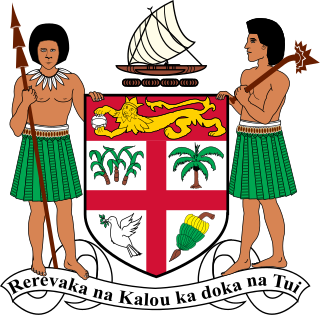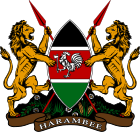
A part of Eastern Africa, the territory of what is known as Kenya has seen human habitation since the beginning of the Lower Paleolithic. The Bantu expansion from a West African centre of dispersal reached the area by the 1st millennium AD. With the borders of the modern state at the crossroads of the Bantu, Nilo-Saharan and Afro-Asiatic ethno-linguistic areas of Africa, Kenya is a multi-ethnic state. The Wanga Kingdom was formally established in the late 17th century. The Kingdom covered from the Jinja in Uganda to Naivasha in the East of Kenya. This is the first time the Wanga people and Luhya tribe were united and led by a centralized leader, a king, known as the Nabongo.

The Kenya African Union (KAU) was a political organization in colonial Kenya, formed in October 1944 prior to the appointment of the first African to sit in the Legislative Council. In 1960 it became the current Kenya African National Union (KANU).

Elections in Kenya take place within the framework of a multi-party democracy and a presidential system. The President, Senate and National Assembly are directly elected by voters, with elections organised by the Independent Electoral and Boundaries Commission (IEBC).

The Legislative Council of Fiji was the colonial precursor to the present-day Parliament, which came into existence when Fiji became independent on 10 October 1970.

The Colony and Protectorate of Kenya, commonly known as British Kenya or British East Africa, was part of the British Empire in Africa from 1920 until 1963. It was established when the former East Africa Protectorate was transformed into a British Crown colony in 1920. Technically, the "Colony of Kenya" referred to the interior lands, while a 16 km (10 mi) coastal strip, nominally on lease from the Sultan of Zanzibar, was the "Protectorate of Kenya", but the two were controlled as a single administrative unit. The colony came to an end in 1963 when an ethnic Kenyan majority government was elected for the first time and eventually declared independence.

General elections were held in Kenya in February 1961. The result was a victory for the Kenya African National Union, which won 19 of the 53 elected seats.
Sir Charles Calvert Bowring was a British colonial administrator, mainly in Kenya, who was later Governor and Commander in Chief of the Nyasaland Protectorate from 1923 to 1929.

General elections were held in Kenya Colony on 2 April 1924. The elections were the first under a new Constitution which saw suffrage extended to Indians and Arabs, who were allotted five and one elected seat in the Legislative Council respectively, alongside the eleven elected seats for the white population, although appointed members were still the majority. Whilst all adult Indian residents were given the right to vote, in the Arab community only men literate in Arabic or Swahili and resident in the country for two years were enfranchised, as the community had requested that women not be given the right to vote. One member was appointed to represent the majority black population.

General elections were held in Kenya Colony in 1934, with the first seats elected on 28 March. Four candidates were returned unopposed in the eleven Europeans constituencies, whilst the remaining seven constituencies were contested by 18 candidates. For the five Indian seats, there were 17 candidates. Voter turnout in the White seats was the highest since elections were introduced. The Council convened for the first time after the election on 24 April.
The Uganda Legislative Council (LEGCO) was the predecessor of the Parliament of Uganda, prior to Uganda's independence from the United Kingdom. LEGCO was small to start with and all its members were Europeans. Its legislative powers were limited, since all important decisions came from the British Government in Whitehall.
The Hilton Young Commission was a Commission of Inquiry appointed in 1926 to look into the possible closer union of the British territories in East and Central Africa. These were individually economically underdeveloped, and it was suggested that some form of association would result both in cost savings and their more rapid development. The Commission recommended an administrative union of the East African mainland territories, possibly to be joined later by the Central African ones. It also proposed that the legislatures of each territory should continue and saw any form of self-government as being a long-term aspiration. It did however reject the possibility of the European minorities in Kenya or Northern Rhodesia establishing political control in those territories, and rejected the claim of Kenyan Asians for the same voting rights as Europeans. Although the commission's recommendations on an administrative union were not followed immediately, closer ties in East Africa were established in the 1940s. However, in Central Africa, its report had the effect of encouraging European settlers to seek closer association with Southern Rhodesia, in what became in 1953 the Federation of Rhodesia and Nyasaland.

The Legislative Council was the legislature of Nyasaland.

General elections were held in Nigeria for the first time on 20 September 1923. The Nigerian National Democratic Party (NNDP) won three of the four elected seats in the Legislative Council.

The New Kenya Party was a political party in Kenya.

The Kenya Indian Congress (KIC) was a political party in Kenya.
Sir Michael Blundell was a Kenyan farmer and politician who served as a member of the Legislative Council from 1948 until 1963, and as Minister of Agriculture in two spells between 1955 and 1962.

The Kenya Coalition was a political party in Kenya.

The Kenya Freedom Party (KFP) was a political party in Kenya.
The Devonshire White Paper or Devonshire Declaration was a document written in 1923 by the colonial secretary Victor Cavendish, 9th Duke of Devonshire, regarding the status of settlers and natives in the Kenya Colony, and East Africa more broadly. The paper stated that whenever the interests of the native Africans clashed with those of Asian, European, or Arab settlers, those of the Africans should prevail. The Declaration blocked the move towards self-government advocated by the colonialists, and in its place advocated a policy of trusteeship, whereby the imperial state would protect the interests of Africans. Although the Paper had little effect on the welfare of native Africans, it nonetheless set a precedent for future conflict resolution between the various groups living in the colony.
The Legislative Council of the Gambia was the legislature of the Gambia Colony and Protectorate from 1843 to 1866, and from 1888 to 1960.








